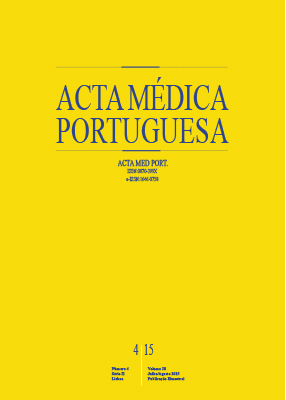Measuring Instruments of the Quality of Life Pediatric Palliative Care
DOI:
https://doi.org/10.20344/amp.5395Keywords:
Palliative Care, Pediatrics, Quality of Life, Questionnaires.Abstract
Introduction: Palliative care is closely linked to the concept of quality of life. In this work we will focus our interest on the need to assess quality of life in oncologic paediatric palliative care.
Objective: To describe/compare instruments for measuring quality of life in Oncologic paediatric palliative care.
Material and Methods: A literature review of the sever a instruments for measuring quality of life of children under palliative care, in English and Portuguese, between 2000 and 2013, was carried out in the recognized databases for this purpose.
Results: We found fifteen measuring instruments: 10 of them were generic and 5 specific. For each instrument the country of origin, the target age group, fill manner, number of evaluated dimensions, description of dimensions, and number of questions, psychometric properties and validation for the Portuguese language were identified.
Discussion: There has been a growing concern in measuring quality of life in pediatric age. Most measuring instruments were designed, in the United States, after 1994, coinciding with the World Health Organization definition of quality of life. As regards to age, most of the instruments were developed for children aged eight or more years old and there is no one to be answered only by the child. We can see that the majority of measuring instruments, namely the most current, seeking to involve the child in evaluating his/her own health related quality of life through auto-population (n = 10). However, there is still a substantial dependence on parents for the measurement of health related quality of life of their children, despite studies demonstrates differences between the child and parents, on perception of health related quality of life. But, since many children are not able to provide data on health related quality of life either due to their age or because they are ill or with functional incapacity, the only possibility to get information about the health related quality of life of these children is to appeal to parents, who are asked to reflect on the lack of their child, or teenager. Thus full completion by parents of some measuring instruments may be justified. In Pediatrics measuring instruments of health related quality of life are multidimensional, often intended to measure the subjective point of view in relation to the impact of the disease and the treatment have on the physical, psychological and social well-being. Thus, the wide range of dimensions, the differences in number of dimensions and the number of questions between the various instruments tend to reflect the different stages of psychomotor development of the target population.
Conclusion: The most commonly measure dimensions were physical ability, emotional/psychological impact, social and at school impact, followed by pain and discomfort and activity level. The majority of instruments are designed for children aged over 8 years. A large number of the questionnaires are self-completion questionnaires. Others can be completed by parents. Most of the instruments tested their internal coherence (n = 9) and, in a small number, the test-retest reproducibility (n = 7) and agreement among observers
(n = 2). Most of the questionnaires reported their content validity (n = 10) and construct validity (n = 9), few have examined the validity of criterion (n = 2). Considering the examined instruments, six questionnaires are validated for the Portuguese population (five generic and one specific for oncologic disease).
Downloads
Downloads
Published
How to Cite
Issue
Section
License
All the articles published in the AMP are open access and comply with the requirements of funding agencies or academic institutions. The AMP is governed by the terms of the Creative Commons ‘Attribution – Non-Commercial Use - (CC-BY-NC)’ license, regarding the use by third parties.
It is the author’s responsibility to obtain approval for the reproduction of figures, tables, etc. from other publications.
Upon acceptance of an article for publication, the authors will be asked to complete the ICMJE “Copyright Liability and Copyright Sharing Statement “(http://www.actamedicaportuguesa.com/info/AMP-NormasPublicacao.pdf) and the “Declaration of Potential Conflicts of Interest” (http:// www.icmje.org/conflicts-of-interest). An e-mail will be sent to the corresponding author to acknowledge receipt of the manuscript.
After publication, the authors are authorised to make their articles available in repositories of their institutions of origin, as long as they always mention where they were published and according to the Creative Commons license.









